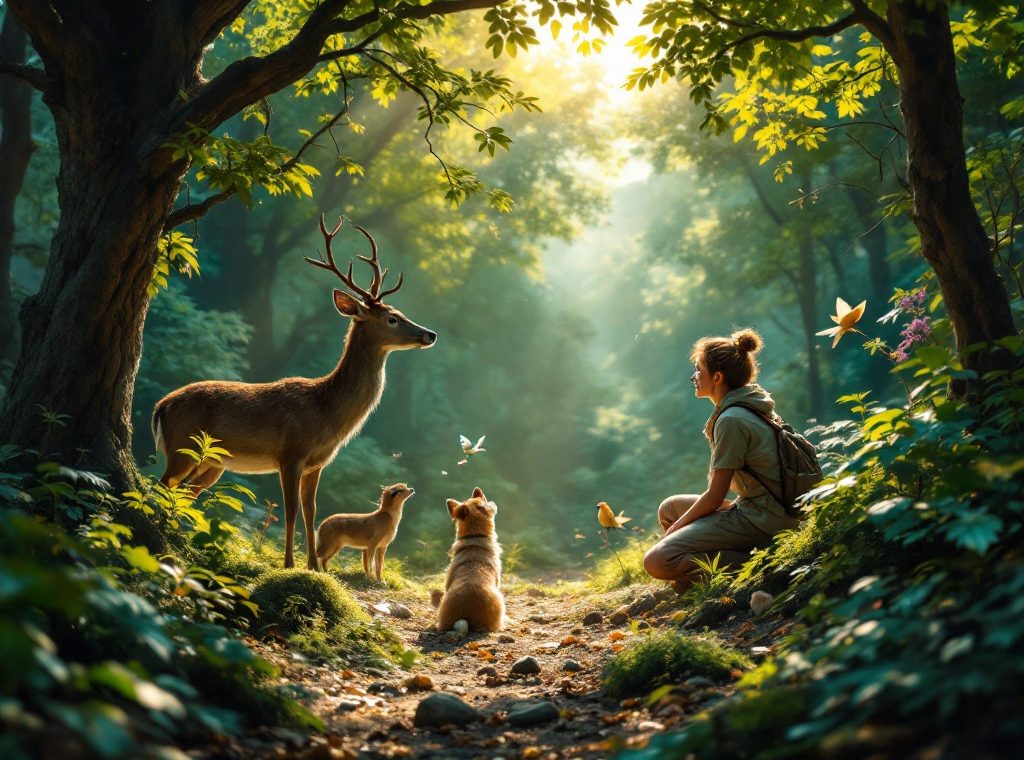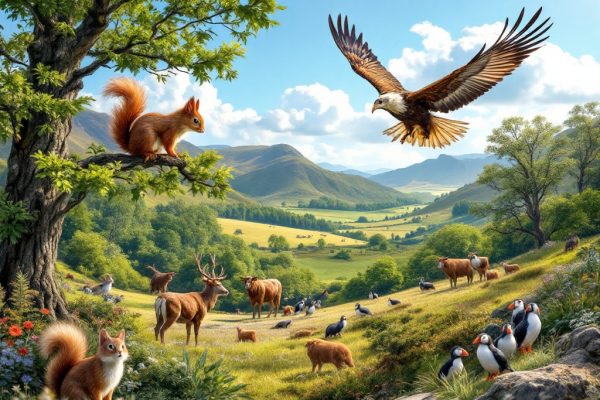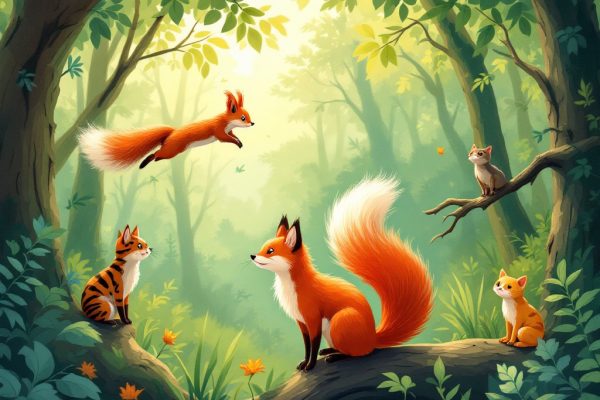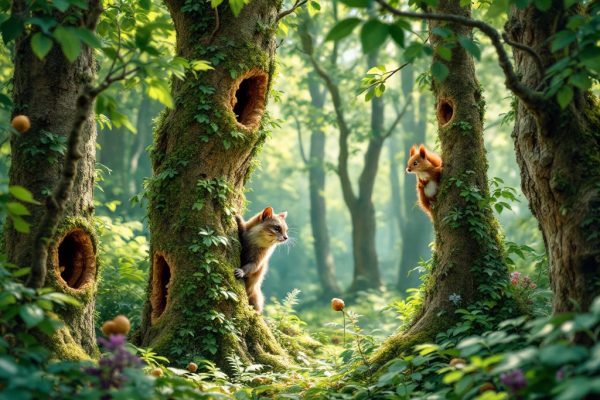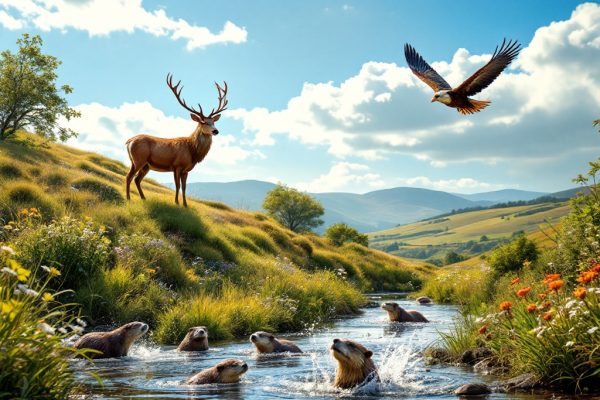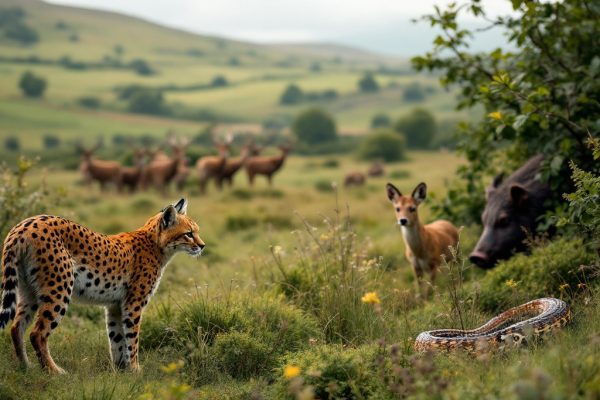How to Speak with Wild Animals
Unlock the secrets of the wild! Discover how to communicate with animals using their own language of body movements, sounds, and subtle cues. Learn to interpret a wagging tail, a bird’s song, or even a deer’s raised tail. This journey into animal communication promises a deeper connection with nature, enhancing your well-being and fostering a greater appreciation for the animal kingdom. Start reading now to build trust, understand animal sentience, and enrich your next wildlife encounter.
Important information
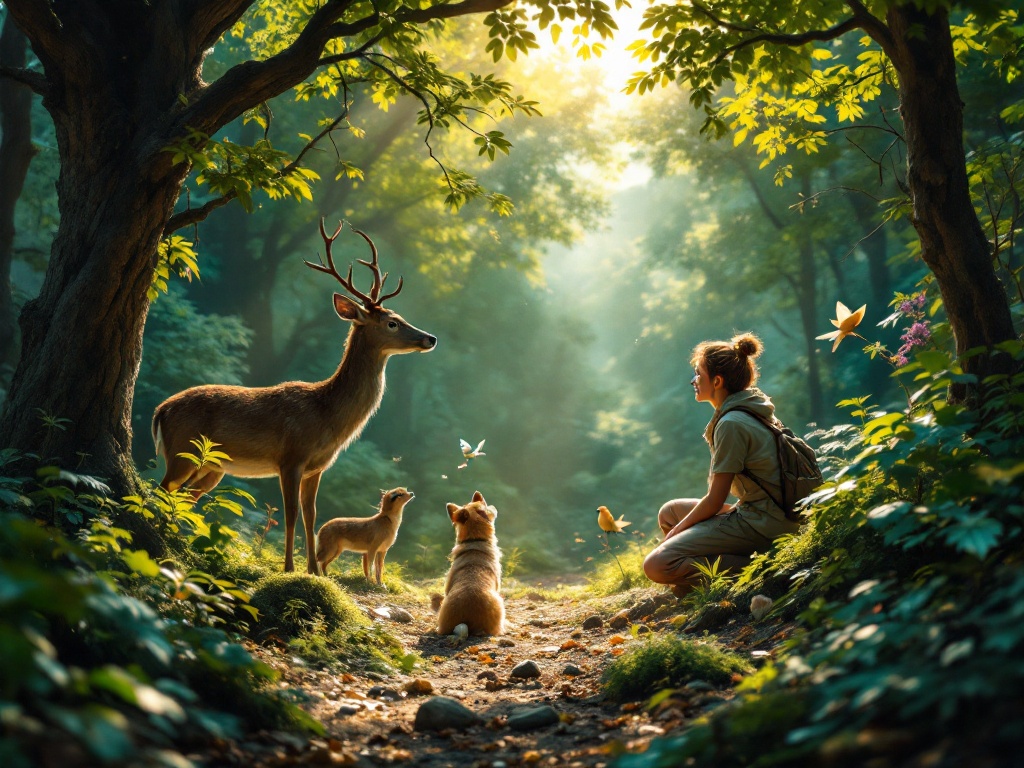
- Animals communicate through body language, sounds, and behaviors. Learn these to connect with them.
- Quiet presence, patience, and respect are key to building trust with wild animals.
- Avoid sudden moves and loud noises, which can scare animals. Never feed or touch them.
- Observe animal behaviors like posture and eye contact to understand their feelings.
- Practice stillness and focus to better perceive subtle animal cues and deepen your connection with nature.
Introduction to Communicating with Wild Animals
Communicating with wildlife offers incredible rewards, providing unique joy and insights into the lives of these sentient beings. Animals communicate intuitively, allowing us to connect with them on a deeper level. By understanding their body language, vocalizations, and behaviors, we can build meaningful connections. Soft sounds and gentle gestures often encourage positive interactions, while respecting their space is crucial for building trust.
Building Connections with Wildlife
Observing an animal’s behavior and body language is key to effective communication. Learning species-specific vocalizations allows us to interpret their messages. A calm presence in nature facilitates open communication and builds the trust necessary for interaction. Patience and respect for their boundaries are essential elements in this process.
Essential Skills for Wildlife Communication
Honing your observational skills and emotional awareness is vital. Mimicking natural calls or using soothing tones can attract an animal’s attention, while loud or sudden noises may frighten them. Some animals respond to calls that mimic their natural communication, while others respond to quiet observation. With patience and understanding, anyone can learn to communicate with wildlife.
Practice and observation, combined with an understanding of animal behavior and a connection with nature, are fundamental to learning this unique language.
Understanding Animal Intelligence and Sentience
Animals experience a wide spectrum of emotions and physical sensations, demonstrating their capacity to feel. Their intuitive intelligence allows for instinctive understanding, crucial for navigating the challenges of survival in the wild. While their perception of the world differs greatly from ours, relying on natural senses and instincts beyond human comprehension, it offers unique insights. Recognizing this intelligence and sentience is fundamental to fostering stronger bonds between humans and animals. For instance, studies on elephant cognition reveal complex emotions and sophisticated social structures, highlighting their high intelligence. The remarkable intelligence displayed by other species further underscores the importance of acknowledging their sentience.
Benefits of Engaging with Wild Animals
Communing with wildlife offers profound benefits, deepening your understanding and appreciation of the natural world. It enhances mental well-being and encourages mindfulness. Hiking and other outdoor adventures become richer and more meaningful with animal encounters. These interactions also foster a sense of responsibility towards conservation, reminding us of the vital need to protect animal habitats.
Preparing to Speak with Wild Animals
Connecting with wildlife requires preparation and clear intentions. An open mind and quiet presence allow us to observe subtle cues, fostering a deeper connection and understanding of the animal’s energy and purpose. Building trust, however, demands patience. Animals react positively to calm, respectful energy. Avoid sudden movements and loud noises, as these can frighten animals, hindering communication and potentially creating a dangerous situation. Here’s how to approach wildlife encounters:
Prepare your mind. Approach wildlife encounters with an open, receptive mindset and a quiet presence.
Be patient and respectful. Building trust with animals takes time and patience. Project calm, respectful energy.
Avoid sudden movements and loud noises. These can startle animals, hindering communication and creating potential danger.
Holding Intentions and Keeping an Open Mind
Connecting with animals relies on a receptive mindset. Focus on building a connection, and communication will become easier. An open mind is crucial, allowing for unexpected insights, as animals communicate through subtle cues like body language or energy shifts. A relaxed approach eases the pressure, fostering a more natural interaction. Patience is key, as interspecies communication requires time and practice. Be open, patient, and ready to connect.
Be receptive. A receptive mindset is the foundation for connecting with animals.
Focus on connection. Prioritize building a bond, and communication will flow more naturally.
Be open-minded. An open mind allows you to perceive subtle cues and unexpected insights.
Relax. A relaxed demeanor reduces pressure and encourages natural interaction.
Be patient. Interspecies communication takes time and practice.
Practicing Stillness and Presence
Stillness quiets your mind and body, minimizing distractions and allowing you to focus on the present moment. This awareness is crucial for observing subtle animal behaviors, as research indicates animals can sense our emotions. A calm presence creates a safe space, encouraging interaction and fostering a receptive state that enhances our understanding of animal communication. We perceive and interpret their signals more accurately. For instance, a relaxed observer might detect a dog’s subtle postural shift indicating anxiety, a cue a stressed observer could easily miss. Stillness deepens our connection with animals and our understanding of their world.
Building Trust with Wild Animals
Earning the trust of wild animals requires patience and consistent behavior. A quiet and safe environment is essential, minimizing disruptions. Avoid sudden movements, loud noises, and direct eye contact. Respecting their space and letting them approach you is key to building trust. Soft, natural sounds mimicking the animal’s own communication can be beneficial. Careful observation of their behavior and body language will offer insights into their responses. Remaining calm and avoiding threatening actions fosters positive interactions. Remember, never feed or touch wild animals. Here’s a step-by-step guide:
Create a quiet and safe environment. Minimize disruptions, loud noises, and sudden movements.
Avoid direct eye contact. Respect the animal’s space and let it approach you at its own pace.
Use soft, natural sounds. Mimicking the animal’s communication can be beneficial in building trust.
Observe their behavior. Careful observation of body language offers insights into their responses.
Remain calm and avoid threatening actions. This fosters positive interactions and builds trust over time.
Never feed or touch wild animals. This is crucial for both your safety and the well-being of the animal.
Methods of Communication with Wild Animals
Animals communicate using a rich vocabulary of behaviors and body language. These non-verbal cues, such as posture, facial expressions, and tail movements, speak volumes. A wagging tail often signifies a happy dog, while flattened ears might suggest fear or aggression. By learning to interpret these subtle signals, we can better understand what animals are trying to tell us. For instance, a study in “Animal Behaviour” revealed that chimpanzees use a complex system of gestures, like extending a hand to request food.
Effective Non-Verbal Communication
Effective non-verbal communication with animals requires both energy and empathy. Our internal state projects outward, influencing how we interact with them. A calm demeanor fosters safety and trust, which are essential for clear communication. Research indicates animals can perceive human emotions, responding positively to calm, positive energy.
Telepathic Communication
Some believe in telepathic communication with animals, claiming to exchange mental images, feelings, and intentions. While scientific evidence remains limited, anecdotal reports suggest its possibility. Those who practice telepathy emphasize the importance of clear intention, focus, and an open mind. Further research is needed to fully understand how this form of communication might work and its potential effectiveness.
Observing Animal Behavior and Body Language
Animals convey a wealth of information through their body language. Posture, movement, and facial expressions can reveal their emotional state and intentions. A relaxed animal typically appears comfortable, while tense muscles or raised fur might indicate fear or aggression. Direct eye contact can be a complex signal, conveying confidence in some species, but a challenge in others. Understanding these subtle cues enhances our ability to communicate with animals and fosters a deeper connection with the natural world. Mirroring calm behaviors, for instance, can build trust. This knowledge promotes respect and safety for both animals and people.
Non-Verbal Communication: Energy and Empathy
Connecting with animals goes beyond words. It’s about energy and empathy. A calm, empathetic mindset creates a bridge for positive, wordless communication. Be present, be compassionate, and be open to the animal’s energy.
Telepathic and Intuitive Communication Techniques
Connecting with animals telepathically involves focused openness and projecting feelings of love and gratitude, which strengthens your bond. Intuition is crucial for understanding their subtle cues and interpreting their messages. For example, a gentle nudge might signify affection, while a stare could indicate a need. Being present enhances this communication.
Practical Steps to Communicate with Wild Animals
Foster connections with wildlife through simple, friendly greetings and loving thoughts. Make this a daily ritual. Inquire about their day and pay close attention to their calls and movements—their way of communicating with you. Watch for signs of understanding, such as direct eye contact or perked ears. Patience and stillness are key; let them approach you. Trust-building requires time. Always respect their space and home.
Greet and think: Initiate connections with simple greetings and loving thoughts daily.
Observe and listen: Pay attention to their calls and movements to understand their communication.
Watch for signs: Look for signs of understanding like direct eye contact or perked ears.
Be patient and still: Allow the animals to approach you at their own pace.
Respect their space: Always respect their boundaries and their home.
Simple Practices: Saying Hello and Sending Love
A simple “hello” to a wild creature can create a connection, a silent acknowledgment of their presence and a wish for their well-being. Expressing gratitude for their existence further strengthens this bond and deepens our appreciation for nature.
Daily Interaction Tips: Asking and Listening
Connect with wildlife daily by asking simple questions like, “How are you today?”. Pay attention to your intuition—those gut feelings and mental images that arise. A quiet mind allows you to truly listen and strengthen this bond, fostering a deeper understanding of their world. You might sense their mood or receive insights into their needs. Always respect their space; this practice builds a bridge between your world and the wild.
Recognizing Messages from the Animal Kingdom
Animals communicate using a captivating array of methods. These include body language, vocalizations, and nuanced scents. Deciphering these cues requires keen observation and an understanding of animal behavior. For example, a deer’s raised tail signals alarm, while a bird’s melodious song heralds mating season. By recognizing these subtle signals, we unlock the secrets of the animal world. Furthermore, the first creature encountered each day may hold symbolic meaning, prompting reflection on our own lives.
Enhancing Your Connection with Nature
Connecting with nature immerses you in the wild, enhancing your ability to perceive subtle animal cues. Honing your intuition strengthens this bond, leading to a deeper understanding of animal communication and behavior. Animals communicate primarily through non-verbal cues, such as body language and subtle energy shifts. By being present, you become more attuned to these messages, enriching your interactions with animals and fostering a more meaningful experience.
Living in the Now and Restoring Natural Connection
Immersing yourself in nature fosters a deeper connection with the wild, opening up communication with animals. By becoming more attuned to their subtle cues, you rediscover your innate bond with the animal kingdom and begin to understand its hidden language.
Developing Perceptive Abilities and Intuition
Immersing yourself in the world of wildlife requires sharpened senses and intuition. By observing closely, you’ll begin to notice subtle environmental cues and even your own intuitive feelings, unlocking the secrets of animal communication. This involves recognizing behavioral patterns, interpreting body language, and sensing subtle energy shifts. Honing these skills requires time, practice, and patience, coupled with a sincere desire to connect with nature. Cultivating presence and mindfulness will attune you to the wisdom of wild animals and their subtle messages. Listen closely, and they will teach you.
Understanding the Animal Mind and Its Lessons
Animals, in their innate wisdom, live authentically, offering us valuable lessons. By observing their behavior, we discover the art of living in the present moment and embracing self-acceptance. Their unique perspectives provide insights into the natural world. Their intuition offers a distinct kind of knowledge, separate from human intellect. This profound connection with nature fosters personal growth and illuminates the interconnectedness of life.
Exploring Deeper Conversations with Animals
Animals communicate through a captivating array of methods, including body language, vocalizations, and subtle energy cues. Deciphering these signals enriches our interactions with the animal world. Animal spirit guides and totems deepen this connection further, symbolizing our inherent link to the animal kingdom. These symbolic figures offer profound insights into personal development and self-discovery.
Connecting with Animals
For those seeking a deeper connection with animals, consider these options:
- volunteer alongside wildlife experts,
- participate in guided experiences.
Benefits of these experiences
These opportunities provide:
- invaluable firsthand knowledge,
- practical skills for respectful interaction,
- a stronger bond with wildlife.
Animal Spirit Guides and Totems
Animal spirit guides and totems provide wisdom and guidance throughout life’s journey, especially during challenging periods. These totems embody specific traits. For instance, the bear symbolizes strength and introspection, while the wolf represents loyalty and intuition. Connecting with your spirit animal can be achieved through meditation, dream analysis, or spending time in nature. These practices cultivate self-awareness and foster spiritual growth.
Volunteering and Experiences with Wildlife Experts
Volunteering offers incredible chances to learn directly from wildlife professionals. These experts share their knowledge about animal behavior, communication, and essential conservation efforts. You can contribute to research projects, help with animal rehabilitation, or take part in educational programs, gaining a deeper understanding of animal needs. Furthermore, these experiences improve communication skills. Imagine helping with wildlife surveys or rescuing injured animals—these are priceless hands-on opportunities.

